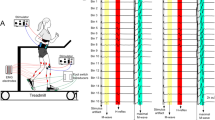Summary
A long lasting inhibition (> 8 s) of the soleus Hoffmann reflex (H-reflex) was evoked by a preceding soleus H-reflex, by a brief voluntary ankle flexor or extensor muscle contraction or by a tap applied to the Achilles tendon. The time course of this long lasting inhibition was similar in all these cases, suggesting that the same spinal mechanism is involved. Furthermore, it was shown that the post-activation depression may interfere with the determination of inhibitory or facilitatory effects on the H-reflex. It is stressed that when the onset of inhibitory or facilitatory effects on the soleus H-reflex is to be determined in relation to start of an ankle movement, either very long stimulus intervals (> 8 s) must be used, or the onset must be determined in relation to a reference value of the soleus H-reflex, which may be influenced by the long lasting inhibitory effect, but not yet by the succeeding muscle contraction.
Similar content being viewed by others
References
Beswick FB, Evanson JM (1957) Homosynaptic depression of the monosynaptic reflex following activation. J Physiol 135:400–411
Brock LG, Coombs JS, Eccles JC (1952) The recording of potentials from motoneurones with an intracellular electrode. J Physiol 117:431–460
Brooks CMc, Downman CBB, Eccles JC (1950) After-potentials and excitability of spinal motoneurones following orthodromic activation. J Neurophysiol 13:157–176
Burke D, Hagbarth K, Lofstedt L, Wallin BG (1976) The responses of human muscle spindle endings to vibration during isometric contraction. J Physiol 261:695–711
Crone C, Hultborn H, Jespersen B (1985) Reciprocal Ia inhibition from the peroneal nerve to soleus motoneurones with special reference to the size of the test reflex. Exp Brain Res 59:418–422
Crone C, Hultborn H, Nielsen J (1987) Reciprocal Ia inhibition between ankle flexors and extensors in man. J Physiol 389:163–185
Crone C, Nielsen J (1989) Spinal mechanisms in man contributing to reciprocal inhibition during voluntary dorsiflexion of the foot. J Physiol (in press)
Curtis DR, Eccles JC (1960) Synaptic action during and after repetitive stimulation. J Physiol 150:374–398
Decandia M, Provini L, Taborikova H (1967) Mechanisms of the reflex discharge depression in the spinal motoneurone during repetitive orthodromic stimulation. Brain Res 4:284–291
Eccles JC, Rall W (1951) Effects induced in a monosynaptic reflex path by its activation. J Neurophysiol 14:353–376
Hoffmann P (1918) Über die Beziehungen der Sehnenreflexe zur willkürlichen Bewegung und zum Tonus. Z Biol 68:351–370
Jefferson AA, Schlapp W (1953) Some effects of repetitive stimulation of afferents on reflex conduction. In: Malcolm JL, Gray JAB (ed) The spinal cord. Little Brown, Boston, pp 99–109
Kagamihara Y, Tanaka R (1985) Reciprocal inhibition upon initiation of voluntary movement. Neurosci Lett 53:400–408
Katz R, Morin C, Pierrot-Deseilligny E, Hibino R (1977) Conditioning of H-reflex by a preceding subthrehold tendon reflex stimulus. Neurol Neurosurg Psychiat 40:575–580
Lloyd DPC, Wilson VJ (1957) Reflex depression in rhythmically active monosynaptic reflex pathways. J Gen Physiol 40:409–450
Magladery JW, McDougal Jr. DB (1950) Electrophysiological studies of nerve and reflex activity in normal man. I. Identification of certain reflexes in the electromyogram and the conduction velocity of peripheral nerve fibers. Johns Hopkins Hosp Bull 86:265–290
Paillard J (1955) Reflexes et regulation d'origine proprioceptive chez l'homme. Thesis. Libraire Arnette, Paris, pp 1–293
Pierrot-Deseilligny E, Lacert P, Cathala HP (1971) Amplitude et variabilite des reflexes monosynaptique avant un mouvement volontaire. Physiol Behav 7:495–508
Rothwell JC, Day BL, Berardelli A, Marsden CD (1986) Habituation and conditioning of the human long latency stretch reflex. Exp Brain Res 63:197–204
Simoyama M, Tanaka R (1974) Reciprocal Ia inhibition at the onset of voluntary movements in man. Brain Res 82:334–337
Schieppati M, Crenna P (1984) From activity to rest: gating of excitatory autogenetic afferences from the relaxing muscle in man. Exp Brain Res 56:448–457
Author information
Authors and Affiliations
Rights and permissions
About this article
Cite this article
Crone, C., Nielsen, J. Methodological implications of the post activation depression of the soleus H-reflex in man. Exp Brain Res 78, 28–32 (1989). https://doi.org/10.1007/BF00230683
Received:
Accepted:
Issue Date:
DOI: https://doi.org/10.1007/BF00230683




